There are two deeply troubling warning signs in the trial of former Minneapolis cop Derek Chauvin for the slaying of George Floyd. The first came when a Black student at Duke University found Floyd’s toxicology report slipped on a Black History Month bulletin board at the university on March 20.
There was nothing about Chauvin on the board; not his long record of misconduct complaints against him, nor his firing. Just bad stuff about Floyd. It was ugly, but not as ugly as the USA/Ipsos poll on the eve of the start of the Chauvin trial. The poll found a stunning reversal in how much of the public, but in reality many whites, viewed Chauvin’s actions and Black Lives Matter. In a word, not very favorable for BLM, and very favorable for Chauvin. Now, George Floyd, not Derek Chauvin, was on trial.
How did that happen? Or better maybe I should say, should we really be surprised at the seemingly stunning reversal? Floyd had a prison record, and a toxicology report did find there were drugs in his system. Chauvin’s defense attorneys made no secret that they would hang much of their defense of Chauvin on this. They’d argue that the nine-plus minutes of his knee on Floyd’s neck didn’t kill him, but the drugs did.
The subtle assault on Floyd has two aims. One is to deconstruct him as supposedly not the innocent victim much of the press has depicted him as. The even more devious and insidious aim is, if not to exonerate Chauvin for the murder, at least present a comforting rationale for why he did what he did to Floyd.
For a time, the hope was that former President Obama’s election had buried once and for all negative racial typecasting and the perennial threat racial stereotypes posed to the safety and well-being of Black males. It did no such thing. Immediately after Obama’s election teams of researchers from several major universities found that many of the old stereotypes about poverty and crime and Blacks remained just as frozen in time.
Penn State University researchers conducted two landmark studies in 2003 and 2008 on the tie between crime and public perceptions of who is most likely to commit crime. The study found that many whites are likely to associate pictures of Blacks with violent crime. This was no surprise, given the relentless media depictions of young Blacks as dysfunctional, dope peddling gang bangers and drive-by shooters. The Penn State study found that even when Blacks didn’t commit a specific crime, whites still misidentified the perpetrator as an African American. The recent poll on Chauvin and race shows little has changed.
The bulging numbers of Blacks in America’s jails and prisons seem to reinforce the wrong-headed perception that crime and violence in America invariably comes with a Black male face such as Floyd’s.
Duke University officials quickly removed the damaging report on Floyd from the bulletin board, and said they’d investigate. OK — and then what? The damage was done. The poll on attitudes on race and the Chauvin trial found that the majority of Blacks condemned Chauvin’s actions. OK, but that’s to be expected. Neither changes the fact that given the power of racial stereotyping, for many, George Floyd, not Derek Chauvin, is on trial.
Earl Ofari Hutchinson is an author and political analyst.






